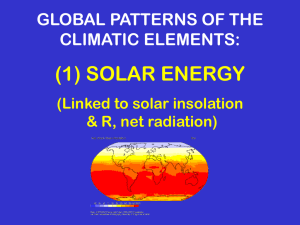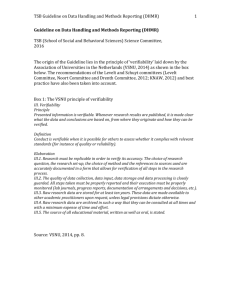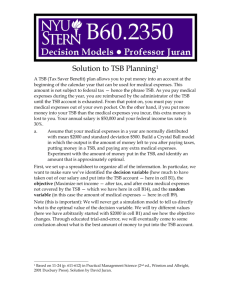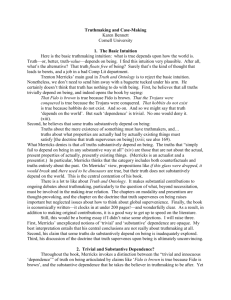Experiment 1 instructions
advertisement
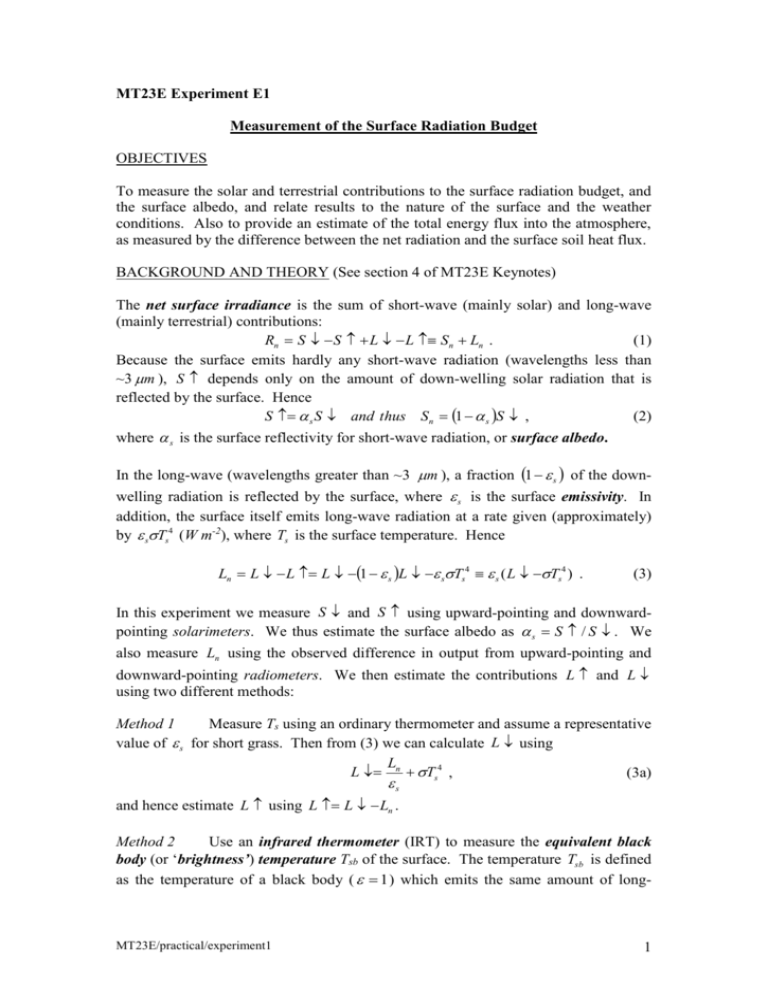
MT23E Experiment E1 Measurement of the Surface Radiation Budget OBJECTIVES To measure the solar and terrestrial contributions to the surface radiation budget, and the surface albedo, and relate results to the nature of the surface and the weather conditions. Also to provide an estimate of the total energy flux into the atmosphere, as measured by the difference between the net radiation and the surface soil heat flux. BACKGROUND AND THEORY (See section 4 of MT23E Keynotes) The net surface irradiance is the sum of short-wave (mainly solar) and long-wave (mainly terrestrial) contributions: Rn S S L L S n Ln . (1) Because the surface emits hardly any short-wave radiation (wavelengths less than ~3 m ), S depends only on the amount of down-welling solar radiation that is reflected by the surface. Hence S s S and thus Sn 1 s S , (2) where s is the surface reflectivity for short-wave radiation, or surface albedo. In the long-wave (wavelengths greater than ~3 m ), a fraction 1 s of the downwelling radiation is reflected by the surface, where s is the surface emissivity. In addition, the surface itself emits long-wave radiation at a rate given (approximately) by sTs4 (W m-2), where Ts is the surface temperature. Hence Ln L L L 1 s L sTs4 s ( L Ts4 ) . (3) In this experiment we measure S and S using upward-pointing and downwardpointing solarimeters. We thus estimate the surface albedo as s S / S . We also measure Ln using the observed difference in output from upward-pointing and downward-pointing radiometers. We then estimate the contributions L and L using two different methods: Method 1 Measure Ts using an ordinary thermometer and assume a representative value of s for short grass. Then from (3) we can calculate L using L L n Ts4 , (3a) s and hence estimate L using L L Ln . Method 2 Use an infrared thermometer (IRT) to measure the equivalent black body (or ‘brightness’) temperature Tsb of the surface. The temperature Tsb is defined as the temperature of a black body ( 1 ) which emits the same amount of long- MT23E/practical/experiment1 1 wave radiation as that being received from the measured surface. It follows that in our case we can calculate L using L Tsb4 , (4) and hence estimate L using L Ln L . [Note that Tsb is theoretically not the same as the actual surface temperature Ts, unless s 1 .] APPARATUS AND METHOD Upward and downward pointing solarimeters produce voltage outputs proportional to S and S . The difference in the voltages output from upward and downward pointing radiometers is proportional to Ln . (Notice that a positive voltage output corresponds to a negative value of Ln .) A heat flux plate is buried just below the surface of the site, and produces a voltage output proportional to the ground heat flux Go. The four voltage outputs are connected via a switch box to voltage integrators. This is designed to measure the mean output voltage from each source over a prescribed sampling interval P. If the total count is N, then the mean output voltage is given by N V k , (5) P where k is the integrator calibration constant. For this experiment you may assume k 1.0 mV s , in which case (5) gives a mean voltage in millivolts when P is measured in seconds. The instruments used in this experiment all have linear calibration characteristics and negligible zero-offsets. Hence if stands for a measured parameter ( S , S , Ln or Go), then it is obtained from the measured mean voltage using V /b , (6) where b is the sensitivity parameter (see calibration sheet provided). A simple electrical thermometer is used to measure the temperature of the surface (Ts). An infrared thermometer (IRT) is used to measure the equivalent black body temperature of the surface (Tsb). THE EXPERIMENT Familiarize yourself with the equipment before the start of the IOP. Operate the counter box to make sure you understand how it works (Green toggles on/off; Red resets to zero). Practice using the IRT to measure the surface equivalent black body temperature. Note that the IRT should be pointed at the area of grass being ‘seen’ by the radiation measuring equipment, from a distance of about 3 metres. Make sure the counters are reset to zero before the start of the IOP. At the start of the IOP, start the voltage integrators at the same time as a stop-clock. During the IOP, take regular measurements of Ts and Tsb (every 2 minutes might be suitable). At the end of the IOP, stop the voltage integrators at the same time as the stop-clock. Carefully record the counts and the total elapsed time P. Hence work out the mean MT23E/practical/experiment1 2 values of S , S , Ln and Go using (5) and 6). Also work out mean values for Ts and Tsb,, and the standard errors of these mean values. ANALYSIS Use (1) to calculate the net radiation Rn from the measured values of S , S and Ln . Also calculate the net energy flux input to the surface as Rn G0 : note that you should report your experimental value of Rn G0 and its accuracy to the groups carrying out experiments 2 and 3. To get the measurement error of Rn, combine the errors of S , S and Ln assuming that the instrument errors are independent and of the order of 3% of the measured values. To get the measurement accuracy of Rn G0 , combine the error on Rn with the error on G0, assuming that the instrument accuracy of the latter is also about 3%. From the measured values of S and S , use (2) to estimate the value of the surface albedo s . Also estimate the accuracy of this estimate. Use (3a) to calculate the value of L using measured values of Ln and Ts, and hence calculate L as L Ln (Method 1). For your calculation, assume an emissivity value for short grass of 0.94. In this method there are three sources of error: L 1 1 Ln . 1 Measurement error in Ln: s Ln L 2 2 s . 2 Uncertainty in s : s 3 Measurement error in Ts: L 3 4 sTs3 Ts . Assume that the uncertainty on s is 0.01 . Decide what is a sensible value for Ts , by considering both measurement and representivity errors. Thus estimate the magnitudes of these three sources of error. Then combine these errors to estimate the overall accuracy of L . It can be shown that because s is not much less than 1.0, the error on L estimated as L Ln is about the same as the error on L . Hence the above estimate can be considered to measure the accuracy of both L and L . Use (4) to estimate L from the measured value of the surface equivalent black body temperature Tsb, and hence estimate L as Ln L (Method 2). If the error on Tsb is Tsb , then the error on L calculated from (4) is L 4Tsb3 Tsb . Use this result to estimate the experimental accuracy of L . Combine this with the accuracy of Ln to estimate the experimental accuracy of L calculated as Ln L . . MT23E/practical/experiment1 3 DISCUSSION Draw a diagram to represent the directions and relative magnitudes of the individual components of down-welling and upwelling radiation, and Sn, Ln and Rn. Interpret this diagram with reference to time of day and sky conditions. Comment on your experimental value of surface albedo. Does this differ significantly from the value expected over short grass? How would you expect the value to vary for (i) concrete, (ii) water? Do methods 1 and 2 lead to significantly different estimates of L and L ? Which method might be considered the most reliable, and why? In the Analysis section, the accuracy of the net energy flux input to the surface was assumed to depend only on the accuracy of the measuring instruments. Identify any other important sources of error that could affect the analysis of the mean energy balance of the sensed surface. MT23E/practical/experiment1 4






